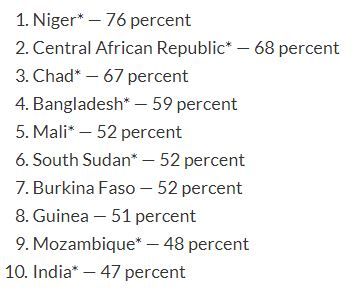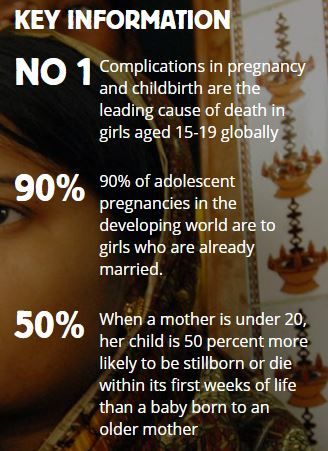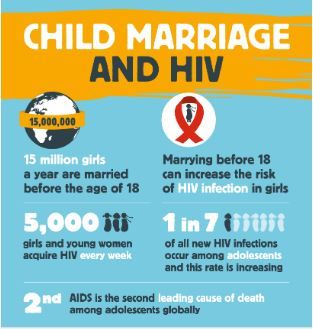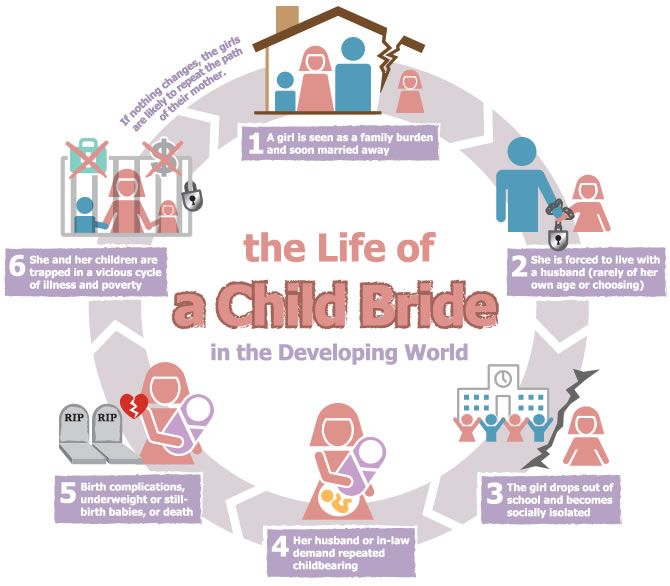Child Marriage- A Global Threat
Aug 22, 2019 • 64 views
Marriage is a tough concept. It takes both emotional and financial stability. But that doesn’t stop people from marrying. Now it is fine and no one’s business if two consenting adults get married. But when it is about minors being married off by their parents or relatives, it becomes a problem for society at large.
Child marriage, as defined by UNICEF, is a formal marriage or informal union by an individual or between two individuals before reaching a certain age. Minors are individuals under the age of 18.
Spread- Global & India
Child marriage dates back to even before Industrial Revolution. Cases of Kings and Queens marrying their sons and daughters early on isn’t unheard of. And even centuries later, we have rampant cases of child marriages. Now the legal age for marriage varies from place to place and in certain cases it might be even less in case of a teen pregnancy.

Top 10 Countries with Highest Rates of Child Marriage - Source: UNICEF 2017 Report
A UNFPA report stated that "For the period 2000–2011, just over one third (an estimated 34 per cent) of women aged 20 to 24 years in developing regions were married or in union before their eighteenth birthday. In 2010 this was equivalent to almost 67 million women. About 12 percent of them were married or in union before age 15."
Let’s see the existence and prevalence of child marriage in some of the countries around the world-
Africa- According to UNICEF, Africa has the highest incidence rates of child marriage, with over 70% of girls marrying under the age of eighteen in three nations. Africa has changed the marriageable age from 16 to 18 but in Ethiopia, Chad and Niger the legal age is 15. However, the local customs and religious courts have the power to marry below 12 years of age. In many tribal areas, the groom pays the bride’s family to marry her.

Conflict & Humanitarian Crisis Results in an Increase in Child Marriages - Source: Girls Not Brides
Americas- The child marriage incidence rates vary between the countries, with Dominican Republic, Honduras, Brazil, Guatemala, Nicaragua, Haiti and Ecuador reporting some of the highest rates in the Americas. Brazil is ranked fourth in the world in terms of absolute numbers of girls married or cohabitating by age fifteen. In 2018, Delaware became the first state to ban child marriage without exceptions, followed by New Jersey the same year.
Asia- More than half of all child marriages occur in the South Asian countries of India, Pakistan, Bangladesh, and Nepal. Afghanistan’s official age for marriage is 15, with father’s consent. For the Karen people it is possible that two couples can arrange their children's marriage before the children are born. Although under Indonesian law underage marriage is prosecuted as paedophilia, unregistered marriages between young girls and older men are common in rural areas. Child marriage rates in Bangladesh are amongst the highest in the world. UNICEF reported that 28.8% of marriages in Nepal were child marriages as of 2011. A custom in Pakistan, called Swara or Vani, involves village elders solving family disputes or settling unpaid debts by marrying off girls. The average marriage age of Swara girls is between 5 and 9. The legal age of marriage in Iran for girls is 13 years old; however, some girls are forced into marriage as young as below the age of 10 years old.
India- Child marriage has been an issue in India for a long time, because of its root in traditional, cultural and religious protection it has been hard battle to fight. Child marriage in India, according to the Indian law, is a marriage where either the female is below age 18 or the male is below age 21. Jharkhand is the state with highest child marriage rates in India (14.1%), while Kerala is the only state where child marriage rates have increased in recent years. Rural rates of child marriages were three times higher than urban India rates in 2009 below 18 years.

Religion-Wise Breakage of Child Marriages - Source: LiveMint (Census 2011)
Europe- Each European country has its own laws; in both the European Union and the Council of Europe the marriageable age falls within the jurisdiction of individual member states. In the European Union, the general age of marriage as a right is 18 in all member states, except in Scotland where it is 16. In the UK girls as young as 12 have been smuggled in to be brides of men in the Muslim community, according to a 2004 report in The Guardian. Girls trying to escape this child marriage can face death because this breaks the honour code of her husband and both families.
Child Marriage Acts
From a legal POV, we have the Hindu Marriage Act, 1955 and the Special Marriage Act, 1954. Although both these acts define the legal age of the bride and groom but a marriage of parties below the defined age is voidable but not void. The marriage becomes valid if the minor doesn’t seek any steps to declare the marriage void.
But when it comes to Child Marriage, India has two acts specifically designed to prevent and in other cases nullify child marriage. The first act that covers child marriage is the Child Marriage Restraint Act, 1929 and the other is Prohibition of Child Marriage Act, 2006.
Child Marriage Restraint Act, 1929- This act aimed to define the age of marriage in India. It fixed the age of marriage for girls at 14 years and boys at 18 years which was later amended to 18 for girls and 21 for boys. It is also popularly known as Sarda Act, named so after its sponsor Harbilas Sarda. The act defines some of the terms used in the act as follows-
"Child" means a person who, if a male, has not completed twenty-one year of age, and if a female, has not completed eighteen years of age
"Child marriage" means a marriage to which either of the contracting parties is a child
"Contracting party" to a marriage means either of the parties whose marriage is thereby solemnised
"Minor" means a person of either sex who is under eighteen years of age.
Punishment- This is an important part of the act. Although the law deems child marriage as a crime, the punishment offered is not even as severe as it is for refusing to sign a statement. If the male adult involved is more than 18 and less than 21 then he will be imprisoned for just a month. That duration goes up to 3 months is the male adult is above 21 years of age. Same is the punishment for solemnising a child marriage or for the parent or guardian of the concerned child. Of course, the punishment is backed by fine but is all this enough? Clearly not! If it was, we would be seeing a decline leading to almost no child marriages. One key point to note here is that women are not subjected to any punishment. This is both a curse and a blessing. Cases in which women use this to their unfair advantage aren’t unheard of.
Prohibition of Child Marriage Act, 2006- To fix the shortcomings of Child marriage Act, 1929, the Prohibition of Child Marriage Act was passed by the legislation in 2006. The changes in name was meant to reflect the prevention and prohibition of child marriage, rather than restraining it. The previous Act also made it difficult and time consuming to act against child marriages and did not focus on authorities as possible figures for preventing the marriages. This Act kept the ages of adult males and females the same but made some significant changes to further protect the children. Boys and girls forced into child marriages as minors have the option of voiding their marriage up to two years after reaching adulthood, and in certain circumstances, marriages of minors can be null and void before they reach adulthood. All valuables, money, and gifts must be returned if the marriage is nullified, and the girl must be provided with a place of residency until she marries or becomes an adult. Children born from child marriages are considered legitimate, and the courts are expected to give parental custody with the children's best interests in mind. This Act also calls appointment of Child Marriage Prohibition Officer for whole or a part of a State by the State government. It is important to note here that a marriage with a minor is not void but voidable that is it is legal if no action is taken but sex with a minor is a statutory crime under Section 376 of the IPC.
Although the Prohibition of Child Marriage Act, 2006 was formed to overcome the shortcomings of Child Marriage Restraint Act, 1929 but it still doesn’t cover all the bases. There is still a long way to go for the laws to prohibit child marriages in India and globally.
Punishment- The punishment for child marriage was increased from 3 months to 2 years of rigorous imprisonment and the fine of Rs. 3000/- was increased up to Rs. 1 lakh. This applies to any male above 21 years of age or if someone tries to solemnise child marriage. It is to be noted here that offense under this act is cognizable and non bailable.Though the punishment is still not adequate, but some progress was still progress.
Reasons
Nevertheless, child marriage is common in many parts of the world, claiming millions of victims annually-and hundreds of thousands of injuries or deaths resulting from abuse or complications from pregnancy and childbirth.
Poverty- This is one of the major and the biggest reason for child marriage in developing and underdeveloped countries like India and Africa. Marrying away the girl means one less mouth to feed and also it brings in money in form of dowry. This money received as dowry is used to educate the boys, to get food, settle debts, buy necessities, for economic or political alliance and escape the cycle of poverty. But this doesn’t go down well for the girl. She is left uneducated and is either forced to work for a living or has to in order to satisfy her and her family’s needs & wants.

Poverty is One of the Key Reasons for Child Marriage - Source: Girls Not Brides
Protecting the “girl’s” sexuality- Some believe that marrying off the girl would ensure protection of her sexuality. Marrying the girl early on is believed to protect them by ensuring that the girl in the picture is a virgin. The imposition of family honour on a girl's individuality, in essence, robbing the girl of her honour and dignity, undermines the credibility of family honour and instead underscores the presumed protection's actual aim: to control the girl.
Gender Discrimination- For years now, girls have been thought of as belonging to the other family- the one in which she marries into. In olden times, women were not allowed to work and that meant an extra mouth to feed and since men worked for a living and to provide for their family, they were considered an asset. This gender discrimination has passed on century after century even though today women are taking lead in almost all sectors, practises like child marriage are not rare. In the backward societies of the world, the beliefs and customs still align with those that existed in the 17th or 18th century.
"The discrimination," according to a UNICEF report on "Child Marriage and the Law," "often manifests itself in the form of domestic violence, marital rape, and deprivation of food, lack of access to information, education, healthcare, and general impediments to mobility."
Inadequate Law- Almost all countries define a marriageable age in their laws, but the laws are not enforced adequately. In those cases, child marriage is not unusual. In Afghanistan, a new law was written into the country's code enabling Shiite or Hazara communities to impose their own form of family law--including permitting child marriage.
Trafficking- Many a times girls are sold off by their families not only into marriage but also into prostitution as it ensures large sums of money. Sometimes they are knowingly married off into a family involved in prostitution.
Consequences
Health- With early entrance into the married life, she is also exposed to sexual activities which may not be always consensual. This leads to unwanted pregnancies, sexually transmitted diseases, complications during childbirth and also in many cases death. Complications from pregnancy and childbirth are the main cause of death among adolescent girls below age 19 in developing countries. Girls aged 15 to 19 are twice as likely to die in childbirth as women in their 20s, and girls under the age of 15 are five to seven times more likely to die during childbirth. These consequences are due largely to girls' physical immaturity wherefore the pelvis and birth canal are not fully developed. Girls who give birth before the age of 15 have an 88% risk of developing fistula. Child pregnancy not only affects the health of the mother but also the health of the new-born. Mothers under the age of 18 years have 35 to 55% increased risk of delivering preterm or having a low birth weight baby than a mother who is 19 years old.

Child Marriage Affects the Young Brides & the Newborns - Source: Girls Not Brides
Following marriage, girls frequently relocate to their husband's home and take on the domestic role of being a wife, which often involves relocating to another village or area. This sense of isolation from a support system can have severe mental health implications including depression. Sexual violence and early pregnancy also have lasting effects on girls’ mental health.

HIV & Child Marriage - Source: Girls Not Brides
Another consequence of child marriage is marital rape. Child brides are more likely to describe their first sexual experience as forced. The child bride won’t always be willing to submit sexually. This leaves her traumatized and she may have difficulty coping up after.
Domestic Violence- Cases of child brides experiencing violence at the hands of her husband or in-laws isn’t not unheard of. Since she is just a child, she is assumed to be gullible, she is expected to work more than her fair share or is asked to do things she wouldn’t want to. When resisted, violence is what follows. Girls who marry before 18 are more likely to face violence from an intimate partner throughout their life. The greater the age difference with their husbands, the more likely they are to experience violence. Globally, 44% of girls aged 15-19 think a husband or partner is justified in hitting or beating his wife or partner.
Illiteracy- Once married, she takes up the role of a wife and daughter-in-law and her studies are stopped once and for all. Without education, girls and adult women have fewer opportunities to earn an income and financially provide for themselves and their children. This makes girls more vulnerable to persistent poverty if their spouses die, abandon them, or divorce them.
Women’s Rights- Child marriage breaks so many of human rights- the right to freedom, access to education, equality on grounds of sex and age, to receive the highest attainable standard of health, to be free from slavery, access to education, freedom of movement, freedom from violence, reproductive rights, and the right to consensual marriage to name a few.

Life of a Child Bride - Source: World Vision
International Initiatives Against Child Marriage
In December 2011 a resolution adopted by the United Nations General Assembly (A/RES/66/170) designated October 11 as the International Day of the Girl Child. On October 11, 2012 the first International Day of the Girl Child was held, the theme of which was ending child marriage.
In 2013 the first United Nations Human Rights Council resolution against child, early, and forced marriages was adopted; it recognizes child marriage as a human rights violation and pledges to eliminate the practice as part of the U.N.'s post-2015 global development agenda.
In 2014 the UN's Commission on the Status of Women issued a document in which they agreed, among other things, to eliminate child marriage.
Indian Initiatives Against Child Marriage
Apni Beti, Apna Dhan (ABAD), which translates to "My daughter, my wealth," is one of India's first conditional cash transfer programmes dedicated to delaying young marriages across the nation. In 1994, the Indian government implemented this programme in the state of Haryana. On the birth of a mother's first, second, or third child, they are set to receive ₹ 500, or US$11 within the first 15 days to cover their post-delivery needs.
Anju Malhotra, an expert on child marriage and adolescent girls said of this programme, "No other conditional cash transfer has this focus of delaying marriage... It's an incentive to encourage parents to value their daughters."
Child marriage is a plague that has not only affected the poor countries but also the world at large. Although all governments & international organizations are trying their best to prevent and ultimately end this curse there is still a long way to go. With baby steps and more importantly enforced and constant efforts, maybe one day we will achieve a world free from child marriages.
